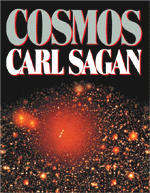
Back الكون (كتاب) Arabic Kosmos (kitab) Azerbaijani Cosmos (buku Carl Sagan) BAN কসমস (বই) Bengali/Bangla Cosmos (llibre) Catalan Cosmos (libro) Spanish Cosmos (livre de Carl Sagan) French Cosmos (buku) ID 코스모스 (책) Korean Cosmos (buku) Malay
 Cover of the first edition | |
| Author | Carl Sagan |
|---|---|
| Cover artist | Adolf Schaller |
| Country | United States |
| Language | English |
| Subject | Cosmology |
| Publisher | Random House |
Publication date | 1980 |
| Media type | Print (Hardcover, Paperback) |
| Pages | 365 (first edition) 396 (2013 edition) |
| ISBN | 0-394-50294-9 (first edition) 978-0-3491-0703-5 (1995 edition) 978-0-375-50832-5 (2002 edition) 978-0-345-53943-4 (2013 edition) |
| OCLC | 6280573 |
| 520 | |
| LC Class | QB44.2 .S235 |
| Preceded by | Broca's Brain: Reflections on the Romance of Science |
| Followed by | Pale Blue Dot: A Vision of the Human Future in Space |
Cosmos is a popular science book written by astronomer and Pulitzer Prize-winning author Carl Sagan. It was published in 1980 as a companion piece to the PBS mini-series Cosmos: A Personal Voyage with which it was co-developed and intended to complement. Each of the book's 13 illustrated chapters corresponds to one of the 13 episodes of the television series. Just a few of the ideas explored in Cosmos include the history and mutual development of science and civilization, the nature of the Universe, human and robotic space exploration, the inner workings of the cell and the DNA that controls it, and the dangers and future implications of nuclear war. One of Sagan's main purposes for both the book and the television series was to explain complex scientific ideas in a way that anyone interested in learning can understand. Sagan also believed the television was one of the greatest teaching tools ever invented, so he wished to capitalize on his chance to educate the world.[1] Spurred in part by the popularity of the TV series, Cosmos spent 50 weeks on the Publishers Weekly best-sellers list and 70 weeks on the New York Times Best Seller list to become the best-selling science book ever published at the time. In 1981, it received the Hugo Award for Best Non-Fiction Book. The unprecedented success of Cosmos ushered in a dramatic increase in visibility for science-themed literature. The success of the book also served to jumpstart Sagan's literary career. The sequel to Cosmos is Pale Blue Dot: A Vision of the Human Future in Space (1994).[2]
In 2013, a new edition of Cosmos was published, with a foreword by Ann Druyan and an essay by Neil deGrasse Tyson.[3]
- ^ Golden, Frederic, Peter Stoler, and Calif. 1980. "The Cosmic Explainer He-e-e-re's Carl, bringing you nothing less than the universe." Time 116, no. 16: 62. Academic Search Complete, EBSCOhost (accessed April 10, 2013).
- ^ "Pale Blue Dot". Powell's Books. Retrieved 3 January 2010.
- ^ Sagan, Carl; Druyan, Ann; Tyson, Neil deGrasse (2013). Cosmos. New York: Ballantine Books. ISBN 978-0-345-53943-4.
© MMXXIII Rich X Search. We shall prevail. All rights reserved. Rich X Search